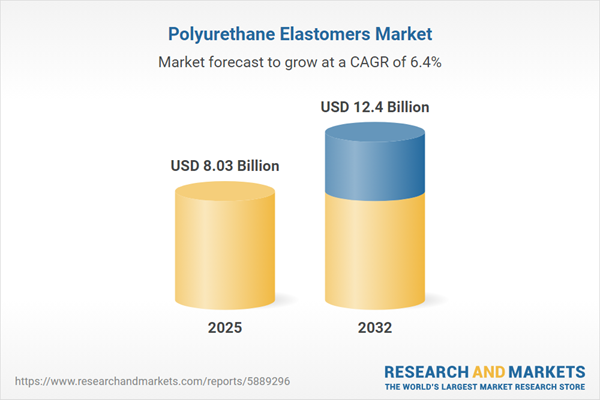Speak directly to the analyst to clarify any post sales queries you may have.
Polyurethane elastomers are increasingly central to resilient supply chain strategies, offering senior decision-makers a flexible, high-performance material for evolving operational demands. Their adaptability supports effective procurement, compliance, and sustainable initiatives across diverse industries.
Market Snapshot: Polyurethane Elastomers Sector Overview
The global polyurethane elastomers market is valued at USD 7.55 billion and is projected to expand at a CAGR of 6.40%. Adoption in automotive, construction, consumer goods, and industrial sectors remains robust, as organizations seek out high-performance materials that respond to regulatory expectations. For senior decision-makers, polyurethane elastomers enable streamlined manufacturing, quicker adaptation to shifting global supply chains, and alignment with responsible production standards. The sector’s growth signals its essential role in markets demanding durability, compliance, and operational agility.
Scope & Segmentation: Polyurethane Elastomers Market
Granular segmentation allows executives to match polyurethane elastomer solutions to industry pressures and strategic objectives, facilitating expansion, innovation, and regulatory compliance in complex markets.
- Product Types: Thermoplastic and thermoset polyurethane elastomers, crafted from polycarbonate, polyester, or polyether chemistry, provide broad compatibility with a spectrum of technical and legal mandates.
- Raw Material Types: Custom formulations using polycarbonate, polyester, or polyether components offer flexibility to meet industry-specific standards and technical requirements across sectors.
- End Use Industries: Automotive, industrial coatings, medical devices, footwear, furniture, bedding, and machinery rely on these materials for proven durability, quick regulatory acceptance, and efficient cost structures.
- Forms: These elastomers can be supplied as adhesives, foams, coatings, and solid products, enabling manufacturers to create flexible designs and respond quickly to supply chain changes.
- Processes: Polyurethane elastomers support scalable production with compatibility for blow molding, casting, extrusion, injection molding, calendering, and thermoforming processes, accommodating different regional and sector-based requirements.
- Geographic Regions: Development and manufacturing flourish in the Americas, Europe, Middle East, Africa, and Asia-Pacific, with local regulations and market environments strongly influencing growth strategies and product positioning.
- Company Coverage: Covestro AG, BASF SE, Dow Chemical Company, Lubrizol Corporation, Huntsman International LLC, Wanhua Chemical Group, LANXESS AG, Mitsui Chemicals, Mitsubishi Chemical Corporation, and Allnex Belgium SA actively shape standards and drive competitive strategies in this arena.
Key Takeaways for Senior Decision-Makers
- Polyurethane elastomers deliver robust operational performance, helping manufacturers enhance efficiency and continuous process optimization over conventional material alternatives.
- Recent advances in catalyst technologies and process optimization are increasing the usable life of elastomer products, enabling more predictable cost controls in production environments where uptime and consistency are critical.
- Organizations are incorporating sustainability principles, including circular economy practices, to build resilience in the face of supply and regulatory uncertainty.
- Widespread adoption of Industry 4.0 digital solutions is elevating process automation, quality management, and end-to-end supply chain traceability across challenging manufacturing contexts.
- Regions such as Asia-Pacific and Europe frequently introduce updated compliance standards, prompting businesses to adapt their strategies in response to regulatory leadership from these markets.
- Strategic partnerships and focused acquisitions empower market participants to remain agile, interpret evolving regulations, and maintain competitive positions in rapidly shifting environments.
Tariff Impact: United States Market Dynamics
The introduction of U.S. tariffs on diisocyanates and related intermediates is driving increased interest in domestic polyurethane elastomer supply chains. Senior leaders are investing more heavily in local production and refining sourcing processes, ensuring supply chain stability and cost management as trade policies shift.
Methodology & Data Sources
This report draws on primary interviews with industry specialists, comprehensive desk research, and verification through regulatory filings and reputable industry publications. This mixed-methods approach delivers reliable, actionable insights tailored for executive decision-making.
Why This Report Matters for Senior Leadership
- Equips executives with practical guidance for aligning procurement and production practices as market dynamics and regulatory requirements develop.
- Offers segmentation frameworks and emerging trend analyses to support compliance efforts and proactive operational planning.
- Helps executive teams enhance supply chain resilience and lead sustainable transformation, maintaining a forward-focused approach to sector developments.
Conclusion
Polyurethane elastomers equip organizations with practical solutions for optimizing efficiency and securing resilient market positioning. This analysis supports senior leadership with clear, strategic direction as sector dynamics evolve.
Additional Product Information:
- Purchase of this report includes 1 year online access with quarterly updates.
- This report can be updated on request. Please contact our Customer Experience team using the Ask a Question widget on our website.
Table of Contents
3. Executive Summary
4. Market Overview
7. Cumulative Impact of Artificial Intelligence 2025
Companies Mentioned
The companies profiled in this Polyurethane Elastomers market report include:- Covestro AG
- BASF SE
- The Dow Chemical Company
- Lubrizol Corporation
- Huntsman International LLC
- Wanhua Chemical Group Co., Ltd.
- LANXESS AG
- Mitsui Chemicals, Inc.
- Mitsubishi Chemical Corporation
- Allnex Belgium SA
Table Information
| Report Attribute | Details |
|---|---|
| No. of Pages | 181 |
| Published | November 2025 |
| Forecast Period | 2025 - 2032 |
| Estimated Market Value ( USD | $ 8.03 Billion |
| Forecasted Market Value ( USD | $ 12.4 Billion |
| Compound Annual Growth Rate | 6.4% |
| Regions Covered | Global |
| No. of Companies Mentioned | 11 |









